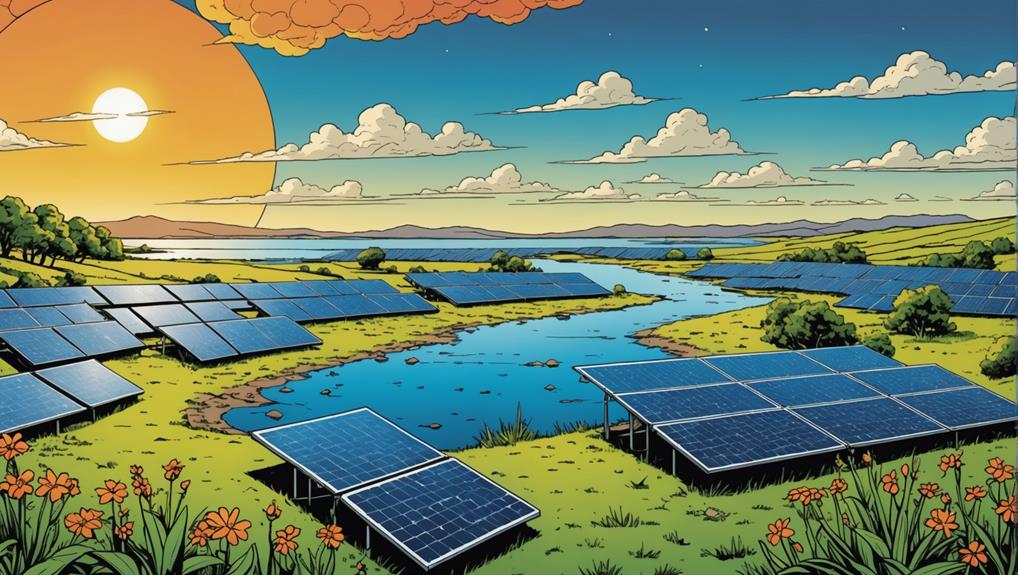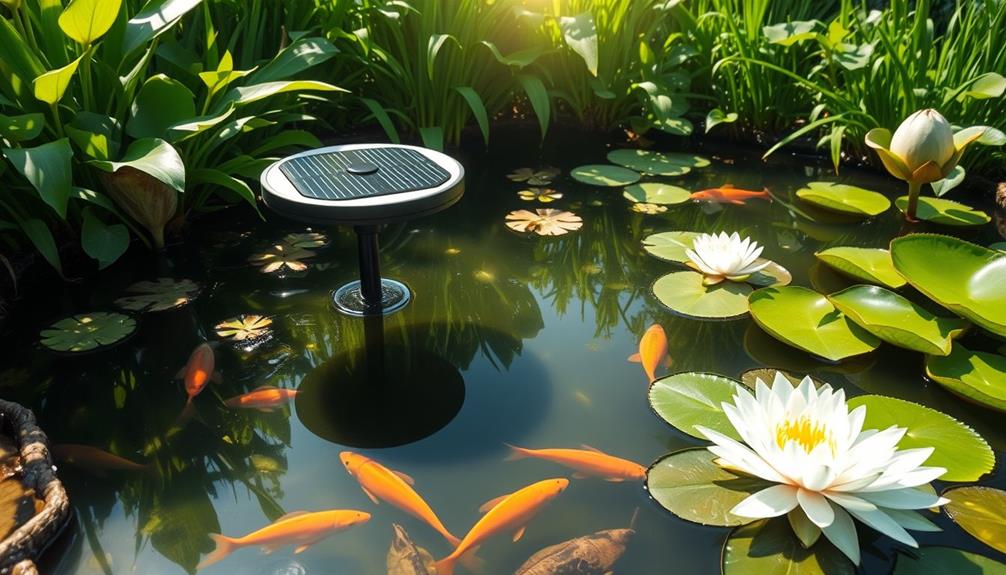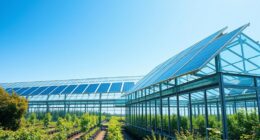Did you know wind energy is growing fast worldwide? By 2018, the world installed 539.6 GW of onshore wind capacity1. China is in the lead at 35%, with the US at 17%. Germany, India, and Spain follow, making wind power a key global energy player.
Wind power is a top clean energy choice for many reasons. It supports over 125,000 jobs in the U.S. wind industry1. It boosts economic growth and cuts down carbon emissions. Wind projects help local economies by paying taxes and leasing land from communities. Plus, wind energy is becoming more affordable, thanks to tech advances, making it a solid choice for making electricity1.
One great thing about wind power is its flexibility. It fits in many places, like farms or remote areas. This lets it bring power to spots where traditional energy might not reach1.
- Wind energy is one of the fastest-growing energy sources globally1.
- Global wind capacity in 2018 was 539.6 GW, with China leading at 35%1.
- Wind power creates jobs, contributing to economic growth1.
- Wind projects provide tax payments and land-lease payments to local communities1.
- Wind energy is cost-effective and can be integrated into various settings1.
Advantages of Wind Power
Wind power is a great way to make electricity. It’s clean and keeps our planet healthy. Plus, it’s good for our economy. Here’s why wind power is so beneficial:
- Wind energy is growing fast in the U.S2.
- It’s a never-ending resource2.
- It’s creating lots of jobs, with the chance to make even more2.
- Running wind turbines is cheap2.
- They don’t need much space2.
Wind power cuts down harmful gases that warm our planet. It can reach places far from cities, offering power security. Wind farms also improve air quality and make us less reliant on dirty fuels.
Yet, wind power faces some issues. It depends on the wind, so it’s not always available. Wind turbines can be loud, and they might harm birds and bats. They are also usually built away from where most people live, needing long wires to carry the electricity.
Still, the good of wind power is much bigger than its problems. It’s a key player in our journey to use more green energy.
Challenges of Wind Power
Wind power is a valuable clean energy source. Yet, it has several hurdles to overcome for broader use. Addressing these challenges is key to its success.
Competition from cheaper energy sources is a big challenge. In areas with little wind, it’s tough for wind power to compete. But, newer technologies and more efficient turbines are making wind power more practical in many places.
3Setting up wind farms and connecting them to the grid requires a lot of infrastructure. To bring wind energy to cities, we need to upgrade our infrastructure. This will make sure wind power is reliably available where lots of people live.
Wind farms can be noisy and might affect the view. These issues can cause people living nearby to oppose wind farms. It’s important to find ways to lessen these effects and gain support for wind projects.
Wind turbines can also harm birds and bats. Researchers are working hard to reduce this by placing turbines carefully and designing bird-friendly turbines.
Research and Innovation
Research and new ideas are vital for overcoming wind power’s challenges. Experts from around the world are working together. They’re finding ways to improve wind power, as shared in the journal Science4.
4Experts are tackling big issues in wind energy, like designing better turbines and understanding air flow. They’re also looking at how to build wind farms that are better for the environment and people. These efforts are making wind power more efficient and less impactful4.
| Challenges | Statistical Data |
|---|---|
| Competition from low-cost energy sources | 5Wind turbines operate in all 50 states, generating over 10% of the US’s energy in 2022. |
| Installation and transmission network requirements | No specific statistical data available. |
| Noise and visual impacts | No specific statistical option. |
| Impact on local wildlife | No specific statistical option. |
The issues wind power faces are solvable. With ongoing research, better technology, and good strategies, wind energy can play a bigger role in our energy supply. It offers a clean, sustainable option for powering our world.
Land-Based Wind Energy
Land-based wind energy is at the heart of the clean energy movement. It uses wind power to create electricity. This helps lessen carbon emissions and fight climate change. Wind energy is the biggest source of renewable power in the U.S., providing over 10% of the country’s electricity6.
A single wind turbine can power a lot of homes. Specifically, a 2.8-megawatt wind turbine can power about 100,000 homes6. These turbines are getting taller to make more energy. By 2022, they reached almost 140 meters high from the ground to the blade tip7.
The U.S. has a lot of land-based wind energy potential. There’s enough to generate between 2.2 and 15.1 terawatts of power in all states and territories7. By 2022, wind energy made up 10% of the nation’s power. In 12 states, over 20% of their electricity came from wind7.
Wind energy is not just good for the environment. It also helps the economy. It creates jobs and gives landowners a new way to make money. The U.S. Department of Energy’s Wind Energy Technologies Office supports the wind energy industry with funding and research7.
The Dry Lake Wind Power Project in Arizona is a great example. It was the first big wind power project in the U.S. with a capacity of 63 megawatts8. The U.S. Department of Energy says land-based wind is among the most affordable ways to generate electricity8.
Some wind farms are huge, covering 100,000 acres. They can power over 250,000 homes8. These projects are key for energy independence. They use our own resources, cutting down on imported energy. This is important for sustainable growth and a cleaner future.
| Advantages of Land-Based Wind Energy | Challenges of Land-Based Wind Energy |
|---|---|
|
|
The Biden administration aims to install 30 gigawatts of wind energy by 2030. This shows how crucial wind power is for America’s energy plans8.
By supporting land-based wind energy, we ensure a cleaner future. It lets us power our lives with renewable energy. Together, we can use wind power to make a difference and tackle climate change.
Solar Power
Solar power is a green and lasting solution for making electricity. It uses photovoltaic (PV) cell panels or passive solar designs.
Solar systems using photovoltaic technology make up 97% of America’s solar capacity9. This method has grown fast. From 2009 to 2019, the cost to install solar dropped by 89%9.
Solar energy is cost-effective. It often costs less than coal in many places in the U.S9.. Plus, battery prices have fallen by 87% in ten years9.
The U.S. can power 18 million homes with solar energy. It can power 32 million homes with wind energy9. Using solar energy helps cut down harmful emissions and moves us towards a better future.
Renewable energy, like solar, will jump from 19% to 38% of America’s electricity by 20509. This increase will help fight climate change by lowering our need for fossil fuels.
Solar power can create many jobs. Nearly 190,000 jobs were in the solar field in June 20209. Solar installers and wind turbine technicians will be among the fastest-growing jobs.
Solar power stands out because it is versatile. Panels can go on rooftops, which is great for cities and suburbs. They can also produce extra energy, which can be sold back to the grid9.
New solar tech is leading to more inventions. Solar windows and roof shingles are being developed to capture solar energy9. These ideas help make solar power a normal part of life and lessen our use of old energy sources.

| Advantages of Solar Power | Challenges of Solar Power |
|---|---|
|
|
Moving to solar power is key for an eco-friendly tomorrow. By tapping into the sun’s power and using less fossil fuels, we are steps closer to a clean planet.
Geothermal Heat Pumps
Geothermal technology takes advantage of the earth’s heat. This provides a green way to heat and cool places like homes and offices. Unlike common systems that use oil or gas, geothermal heat pumps use the earth’s steady temperature. This offers comfort all year round.
Geothermal heat pumps are great for saving money over time. Yes, they’re more expensive to set up than usual HVAC units. But, they cut down on power use, which saves money10. They also need less fixing up and last longer because they use the earth’s constant temperature10. This means they’re cheaper to maintain and more dependable, making them a smart choice for saving energy in the long run.
A 2019 study called GeoVision showed big possibilities for geothermal power. By 2050, we could have up to 60 gigawatts of electricity from geothermal sources11. The study also found we might use geothermal energy for over 17,000 heating projects by then11. Plus, up to 28 million geothermal heat pumps could be in use by 2050. This shows how popular and useful geothermal energy could become11.
Geothermal pumps have benefits traditional air systems don’t. They work well in all climates because they don’t rely on the outside air10. They keep you comfortable no matter the weather outside. Plus, they’re quieter, which makes your home or office more peaceful10.
Geothermal heat pumps can also save a lot of energy. A DOE study found they could cut the need for about 24,500 miles of new power lines by 205010. This shows how geothermal technology could help make our energy use more sustainable and reliable.
Universities and communities are also trying out geothermal systems on a big scale. These setups offer a green way to manage temperature for big buildings or whole communities10. It shows how more people are adopting this clean energy method.
Geothermal power plants are another cool use of this technology. They get steam or hot water from deep underground12. This natural heat is then turned into electricity. Geothermal plants are key for moving towards cleaner energy because they use the earth’s renewable heat and cut down on fossil fuels12.

| Advantages of Geothermal Heat Pumps | Statistics |
|---|---|
| Long-term cost savings | Offset initial investment10 |
| Energy efficiency | Saves enough energy to avoid as much as 24,500 miles of new grid transmission lines by 205010 |
| Quiet operation | Provides a comfortable indoor environment10 |
| Lifespan | Longer lifespan and lower maintenance costs compared to traditional air conditioners10 |
Small Wind Systems
Small wind systems offer a sustainable way to make electricity in various places. They work well if you live far from cities, have a ranch, or want to use less grid electricity. These turbines can cut your electricity cost by 50%–90%13 and are great for remote spots13. They’re reliable during power outages, keeping essential devices running13.
Most small wind turbines have a horizontal axis and two or three blades13. These blades are usually made from strong materials like fiberglass13. A turbine’s power output largely depends on its rotor size13. To get more wind and generate more electricity, placing the turbine higher is key13.
Small wind systems use two main types of towers: self-supporting and guyed. Each type is designed for specific situations. There are also tilt-down versions, which make maintenance and setup easier13. Besides the turbine and tower, other components are needed for these systems to work well. The exact parts vary based on the system’s use, ensuring it works smoothly and efficiently13.

Residential small wind turbines range from 400 watts to 20 kilowatts in size14. For a good impact on home electricity, models between 5–15 kilowatts are best14. It’s crucial to figure out if a turbine can meet your energy needs before getting one14. If connected to the grid, turbines can reduce your electricity use or even give you credit for extra energy produced14.
Wind energy systems are a great choice for rural homes or properties over an acre15. They can lower your electricity costs by 50% to 90%15. For areas with less wind, traditional windmills are an economical way to pump water15. You can choose from turbines that are 20 watts to 100 kilowatts, depending on your needs and local wind conditions15. Given that the average home uses about 10,000 kilowatt-hours annually, wind systems can make a significant dent in energy use3
Selling the Energy You Collect
Generating energy from wind or solar systems allows you to power your home and more. If you have wind turbines or solar panels, you can sell any extra energy. This helps create a cleaner, more sustainable future.
If your wind turbine connects to the grid or makes more power than you use, you can sell the surplus. Wind-generated electricity can be used by you or sold into the electric grid16. State rules let you sell extra electricity back to the utility, paying you for it16.
Wind generators can sell power in spot markets or to wholesale buyers16. Electric companies might use wind turbines to give renewable energy to their customers. This opens more chances for sales. Wind generators can also offer services like voltage support16.
Wind power can be sold through Renewable Energy Certificates (RECs) too, which show the energy’s environmental benefits16. RECs can be traded, showing your contribution to green energy16. Wind energy can also play a role in emissions trading, supporting cleaner air16. There are programs to help with this, like the Regional Greenhouse Gas Initiative16.
Solar panel owners can also sell extra energy back to the grid. By connecting your solar home to the grid, you can benefit from net metering. This way, you cut down on your energy bills and make some money16.
Solar panels convert about 22% of sunlight into electricity17. So, you might produce more energy than you need, allowing you to sell the excess. This helps pay off your solar system and supports the use of clean energy16.
Selling energy you make with wind or solar power is good for the planet and can save you money. People buy green energy for many reasons, like helping the environment or meeting goals. By using wind or solar energy, you help make the world cleaner and greener16.
Renewable Energy and You
You can help grow renewable energy and create a better future. By using clean energy, you help the planet and move us away from dirty fossil fuels. You can make a difference by supporting green policies or using renewable technologies yourself.
Solar power is a great way to use renewable energy. It lets homeowners make their own electricity with solar panels. Even if you can’t install solar panels, you can choose clean energy from your power company. Many offer wind or hydro power options.

You can also buy Renewable Energy Certificates (RECs) if your power company doesn’t offer green energy. RECs show you’re helping the environment by using renewable energy. Buying RECs supports the growth of renewable energy projects.
Wind power is another good choice for clean energy. Individuals and communities can use wind turbines to generate power. Small turbines help various industries produce their own energy. This way, you can use wind to power things directly wherever you are.
Wind power has grown a lot recently. In the last ten years, the U.S. added 30% more wind power18. This created over 100,000 jobs in 41 states with big wind farms18. So, wind energy is good for the environment and helps our economy grow18.
Wind energy also cuts down on pollution. The U.S. could reduce 12.3 gigatons of greenhouse gases by 2050 with wind energy19. Fixed pricing from wind could save people $280 billion by then19. Plus, jobs for wind technicians are expected to jump by 68% by 2030, making it a fast-growing job field in America19.
Choosing renewable energy lowers your impact on the environment. It helps speed up the move to a clean, sustainable future. Whether by getting solar panels, pushing for green policies, or backing wind projects, everyone can help in the shift to renewable energy.
Available Clean Energy Solutions
Several available clean energy solutions exist for sustainable energy needs. Wind turbines, solar power, geothermal heat pumps, and small wind systems are eco-friendly alternatives to traditional energy. Each option comes with its own benefits and things to consider. It’s important to think about location, what energy is needed, and the budget.
Wind power comes with significant advantages. Wind turbines turn wind into electricity, offering a renewable, clean source of energy. The Department of Interior aims to set up 30 gigawatts of offshore wind by 2030. This shows the growing importance of wind technology in making our energy use greener20. They also plan up to 12 offshore wind energy lease sales by 2028, highlighting the increasing interest in this field20.
Solar power is another great clean energy source. It uses solar panels to turn sunlight into electricity. This lets homeowners and businesses create their own renewable energy. Over two million U.S. homes have solar panels, showing how popular this technology has become21. Also, utilities and companies are setting up solar farms to use the sun’s power on a bigger scale21.
“Large-scale storage operations in the United States are still relatively rare. Energy storage technology is a critical component for creating a low-carbon electricity system.”
As green energy from wind and the sun grows, and coal plants decrease, storing energy gets more critical. We need it to make sure renewable sources provide steady and reliable power for everyone21. Energy storage helps deal with the ups and downs of renewable energy, making our power supply constant and reliable.
Geothermal heat pumps use the earth’s heat for an efficient way to heat and cool buildings. Even though they only made up 0.4 percent of the U.S.’s electricity in 2021, their potential is big22.
Small wind systems are good for homes and small uses. These can be set up on rooftops or in small wind farms to make electricity. They’re not as common as solar panels but offer a good alternative to usual energy sources. They help make our energy mix more varied.
In conclusion, looking for available clean energy solutions leads us to wind turbines, solar power, geothermal heat pumps, and small wind systems. Each has unique benefits and considerations, showing how we can generate energy sustainably in different ways. By using nature’s power, we move towards a greener, cleaner future.
Transitioning to Clean Energy
Moving to clean energy is vital for a better future. It helps us lessen our carbon footprint. By using renewable energy and efficient technologies, we can help stop climate change. This will also protect our world for the ones coming after us. Let’s look at the good, the hard, and the solutions in moving to clean energy.

Benefits of Transitioning to Clean Energy
Switching to clean energy has many benefits. Right now, 29% of the world’s electricity comes from renewables23. The goal is to get this to 60% by 203023. Using solar, wind, and water power will cut down harmful gases. It will also reduce our use of fossil fuels. Plus, clean energy means better air and water quality, something 59% of Americans support24.
This shift also creates jobs and grows the economy. Around 49% of Americans think renewable energy will offer more jobs24. As we build and use new green technologies, we need people. Jobs will be available in manufacturing, setting up, and maintaining these systems.
Challenges of Transitioning to Clean Energy
Yet, shifting to clean energy has its hurdles. One big issue is keeping energy storage effective and grids reliable, especially with solar and wind energy25. Battery storage can help. It lets us save and use electricity from renewable sources when we need it23.
Money is another challenge. Starting up needs a lot of investment in technology and infrastructure25. But, investing in clean energy pays off in the long-run. This is because it helps our environment and energy security. Laws and policies from governments can make it easier to use renewable energy25. They offer support and set rules to encourage the use of clean tech.
Available Clean Energy Solutions
Many solutions exist to help us use more clean energy. Solar and wind are great green options for making electricity. They use natural processes and hardly harm the environment25. Carbon capture, which traps greenhouse gases, is also important25.
Utilities, companies, and NGOs all help in providing sustainable technologies. Utilities work on making energy use better and changing business ways25. Companies invest in green projects and speed up the energy switch25. NGOs play a big role in areas where the government and businesses aren’t as involved. They push for change, do research, and help start projects25.
Investors help by putting their money into clean energy, sparking innovation25. Everyone’s effort is needed to reach a clean energy future.
In conclusion, moving to clean energy is a must for the environment and our economy. By choosing renewable sources, solving challenges, and using new solutions, we can have a greener future. Let’s make clean energy a top goal and fight climate change together.
Conclusion
We can create a better future by choosing clean energy like wind turbines and power plants. These sources offer big benefits. They help lower carbon emissions and are cost-effective. They also create jobs and boost the economy. Wind turbines could supply about 10% of the U.S.’s electricity26.
But, the growth of wind power has slowed. This happened after tax incentives ended26. Yet, some U.S. companies still make wind turbine blades26. A major Japanese company is now competing in wind power, along with Europe26.
Choosing wind power comes with its challenges. Switching to wind or solar needs more land than we thought27. Wind farms may slightly warm the U.S. mainland27. However, they cool the poles, as studies show27. A 2011 study says they can cut carbon emissions28.
To sum up, clean energy is vital for a green future. Wind power has its pros and cons. But through research, we aim to improve it. By supporting clean energy, we contribute to a healthier planet tomorrow.










